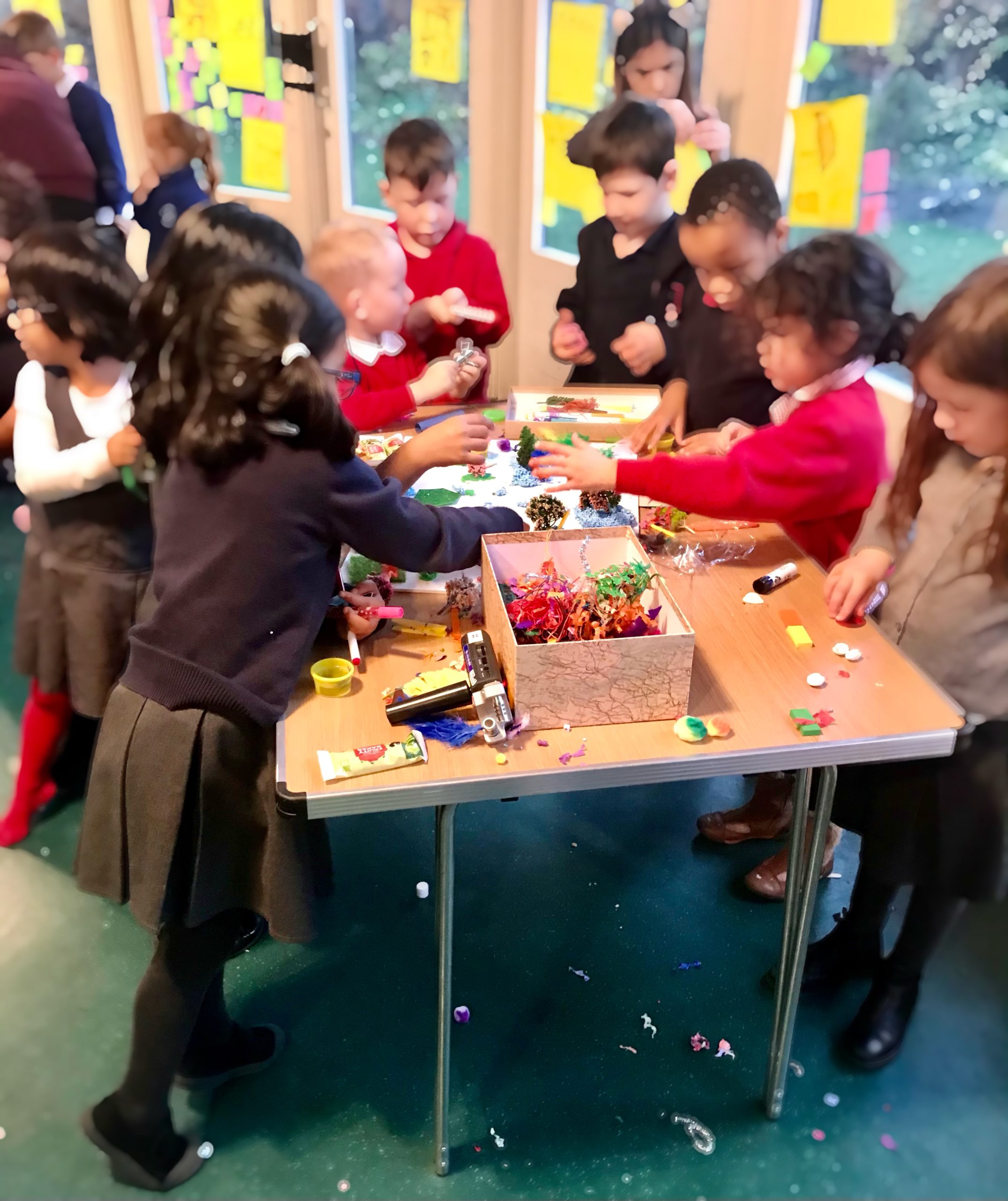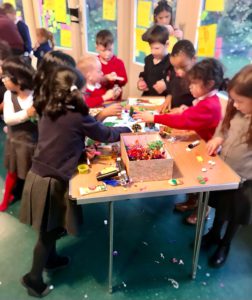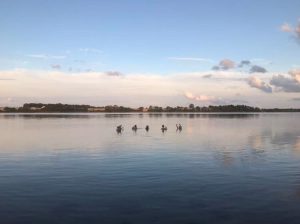The government’s road map in controlling the global pandemic, promises easing the restrictions on outdoor activities in spring. I am particularly looking forward to re-bonding with nature without the shadow of currently-necessary restrictions looming over my head. A research project that I led last year before the pandemic, highlights the significance of nature in our happiness, and so this blog is to encourage you to squeeze some time out in the nature in your days whenever you can by recounting some of my findings. Designing My Happy City: Playground [1] was a hands-on workshop tailored for primary school children, providing 54 kids with crafting material to design their favourite playground in groups; and permitted a closer look at patterns of users’ experience in playground settings, that is vital in promoting its spatial quality. Designing My Happy City was generously funded by ESRC to collect the participants’ outputs by exploring the design of a playground, in the hope of enriching it and of expanding the range of children participation. In addition to inspiring further research on the children’s contribution to our understandings of happiness and its spatial narratives. Children used recreational architecture means to draw and model creative solutions for a happier city.
The drawings and models could be gauged as a reflective evidence for what children find imperative to a happy place and more than 40 percent of the workshop’s drawings include natural elements _ the sun, stars, trees, clouds and mountains, as well as water. The current literature landscape has identified the vital role of nature in children’s learning processes. [2] But it seems that children’s fascination with nature is not limited to its ability to stimulate learning; as we get to know the world we are living in, we start bonding with its familiar traits. The daily rise of sun and the appearance of stars at night, anchor us to the world and are entwined with our experience of life. We are also in awe of nature, it never ceases to make us wonder, as we keep “Rediscovering the joy, excitement, and mystery of the world we live in.” [3] It is no surprise that tourist attraction maps often highlight best points of the city for sunrise or sunset watching and at times, stargazing hotspots. [4] All the natural elements in children’s drawings are indicators of their appetite for nature and therefore the need for intertwining urban and natural environments “As essential a part of the basic infrastructure of a settlement as electricity, water, sewage and paving.” [5]
Children also drew flowers, or fruits on the trees, like a cherry tree. Both empirical and theoretical studies have attributed children’s fascination to the interactive nature of such elements. A case of foundational approach to the study of “active investigation” was concluded by Sue Waite [6] in her article, Memories are made of this, in which Waite investigates outdoor learning benefits by means of 334 survey practitioners with children aged between 2 and 11. Waite argues that active investigation is a form of play that incorporates autonomy and perceptible contact that increases memorability. [7] Waite quotes one of her survey results that draws on “happy hours” of active investigation with plants and animals. [8]
“Caravan holidays in west Wales, small site with no onsite entertainment so I spent many happy hours catching frogs, playing ball games, picking apples, blackberries. I often went to the beach, rock pool rambles with my brother and parents. I loved looking at nature, freedom to wander around the local fields.” [9]
This was previously discussed by Nicholson in 1971, as the possibility of discovery, and the spatial variables that escalate its likelihood. [10] For instance, where deciduous trees are reportedly popular and more accessible for climbing and swinging, [11] fruit trees are able to provide distinctive opportunities for children’s engagement with smell, taste, gravity, material and so on. Senses are awakened in nature largely, however the field components, can ignite even more sensations; “Children find flowers necessary for aesthetic (beautiful), atmospheric (nice-smelling) and restorative reasons (making people happy). Alongside aesthetics, being able to explore and interact in and around the flower garden was also important to the children.” [12] Through this study’s drawings that included plants and animals, (more than 11 percent of drawings was dedicated to animals) an intriguing point is conceived, children are interested in spatial settings that allow and encourage inter-species emotive engagement. Clearly plants, fruit trees and bushes can draw birds, butterfly and bees, while providing routes for cats and dogs; and children are seeing themselves at the linchpin of this interaction. In a radical interpretation it is arguable that children are also implying no one’s happiness would be complete without the happiness of its companions, including other people or animals.
It is no coincidence that nature is the most highlighted theme in the workshop results. As Richard Louv, the prised author of Vitamin N suggests; for a healthy, happy and fulfilling life, nature can make all the difference. [13] In weathering these challenging times; taking your Vitamin N regularly could be of great help. So, this spring make some time out in the nature, and ask others to do the same. If you are a designer or writer, let it be your muse; if you are in policy making, let us have more green spaces! Whatever field you are in, open the door to the nature and let us build the yellow bricked path together, one brick at a time.
I am currently leading Edinburgh CCC project, see more or join here: https://edinburghccc.eventbrite.com
Footnotes:
- The workshop was supported by a grant awarded by the Economic and Social Research Council, ESRC. I was awarded to lead “Designing My Happy City: Playground” workshop in the Festival of Social Science (FOSS) that was held from 2-9 November 2019. For more details, visit: https://esrc.ukri.org/public-engagement/festival-of-social-science/festival-events/ or #esrcfestival.
- Alison Clark, ‘Views from inside the Shed: Young Children’s Perspectives of the Outdoor Environment’, Education 3-13, 2007. Also see Harriet Dismore and Richard Bailey, ‘“If Only”: Outdoor and Adventurous Activities and Generalised Academic Development’, Journal of Adventure Education & Outdoor Learning, 2005.
- Richard Louv, Vitamin N; The Essential Guide to a Nature-Rich Life (New York: Algonquin Books of Chapel Hill, 2016).
- See TripAdvisor’s reviews for sunrise/sunset watching in Edinburgh. https://www.tripadvisor.co.uk/ShowUserReviews-g186525-d190124-r161007770-Calton_Hill-Edinburgh_Scotland.html (Date accessed: 11/11/2020)
- Kay Carmichael, ‘Book Review: Growing Up in Cities Edited by Kevin Lynch. London: The MIT Press and UNESCO. 1977. Pp. 177. The Child in the City by Colin Ward. London: The Architectural Press Ltd. 1978. Pp.221. Parents and Children in the Inner City by Harriet’, Urban Studies, 1979.
- Sue Waite is Associate Professor (Reader) in Outdoor Learning in Plymouth Institute of Education at Plymouth University. Over the last 20 years, she has conducted and published research on how place, people and pedagogies interact to support positive social effect in play, learning, health and wellbeing through the great outdoors.
- Sue Waite, ‘“Memories Are Made of This”: Some Reflections on Outdoor Learning and Recall’, Education 3-13, 2007. See page 339.
- Ibid.
- Ibid.
- Professor Nicholson in 1971 published an article about “The theory of loose parts” in Landscape Architecture No 62, under the title of “How NOT to cheat children”. His works mainly centres on how play in interactive environments _containing loose parts; can serve educational purposes. See more: Ingunn Fjørtoft and Jostein Sageie, ‘The Natural Environment as a Playground for Children. Landscape Description and Analyses of a Natural Playscape’, Landscape and Urban Planning, 2000. Also see: Richard Louv, Last Child in the Woods (New York, USA: Workman Publishing Company, Inc., 2008).
- Ibid. See page 93-94.
- Matluba Khan, ‘Environment, Engagement and Education’ (The Uninversity of Edinburgh, 2017).
- Louv, Vitamin N; The Essential Guide to a Nature-Rich Life. See page 3.





Responses